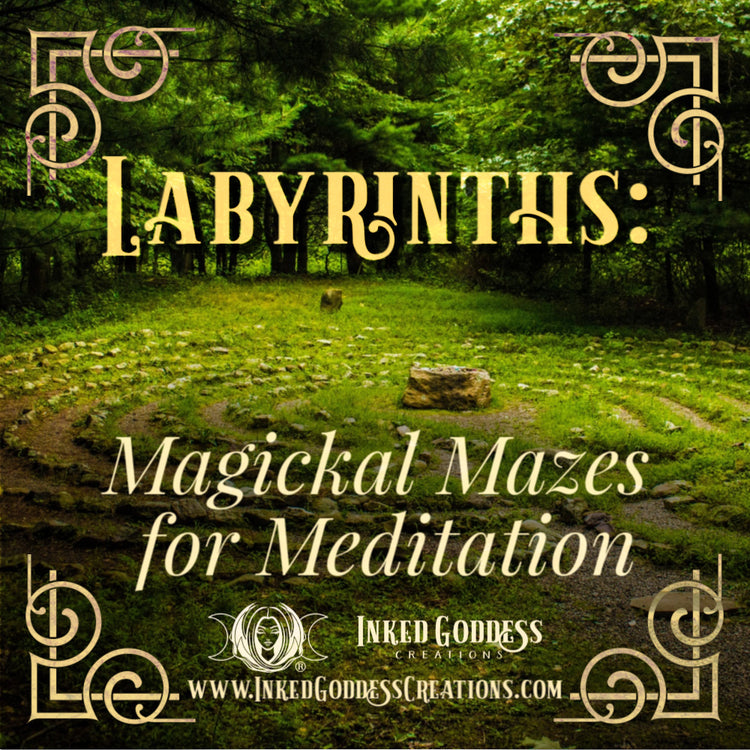Labyrinths: Magickal Mazes for Meditation

When you think of a labyrinth, what comes to mind? Is it a story from myth, or have you walked along one yourself? Most of us are familiar with mazes – walkable puzzle-like paths with barriers to the exit – but labyrinths are something quite different. Often used for meditation or magick, a labyrinth is a path cut into the landscape in a circuitous pattern, leading to a center point. Its object isn’t to confuse you, but instead to inspire you!
History of Labyrinths
Labyrinths show up across the historical record and cultures. The pattern can be found in early Americans’ basket weaving designs, cave drawings, and petroglyphs. Labyrinths and similar designs are present on artifacts from the Neolithic Period – the last stage of the Stone Age – found in modern-day Turkey, Greece, Ireland, and India.
The concept of the labyrinth as we know it today probably comes from the Cretan myth of the Minotaur, but since the design is present in so many different relics and historical records, it’s hard to point at one specific origin. In the Middle Ages, labyrinths appeared in cathedral naves, and later in English gardens. You can also find labyrinthine designs in mandalas and ancient Indian texts. The earliest written record of a labyrinth comes from Herodotus, a Greek historian, who wrote about a two-story labyrinth in Ancient Egypt.
A Labyrinth isn’t a Maze
When walking a labyrinth, you start at a beginning point and then make your way to the center. Once in the center, you have to turn around and walk back out of the labyrinth the same way you came in. Unlike a maze, which has breaks in the path that challenge you to find the way out, a labyrinth is one continuous path. You can also see the entire labyrinth as you walk it, which adds to the experience.
While both labyrinths and mazes can be either simple or complex, labyrinths are less of a puzzle than a maze and are intended as a place of reflection instead of play. In fact, a labyrinth is sometimes called a “maze with magick.”
Using a Labyrinth in Meditation
If you ever happen to come across a labyrinth in your travels, take some time to walk along its path mindfully. In the Middle Ages, labyrinths in cathedrals served as stand-ins for a pilgrimage to Jerusalem, and although that may not be your goal – or even your religious background – walking a labyrinth can be symbolic of walking towards a goal or your higher self.
A finger labyrinth is a great tool for personal meditation, as well. Using a small labyrinth, trace your finger along its path, just like you would walk the path of a larger one. Take a few deep breaths and then place your finger at the start of the labyrinth. As you trace the pattern, try to clear the thoughts that come to your mind and focus instead on the way the labyrinth feels under your finger. When you reach the center, take a few moments to breathe and notice how you feel. Then, follow the path “out” of the labyrinth to finish your meditation.
Another way to use a labyrinth is to begin your walk – or finger trace – by asking a question or thinking of an issue you would like some clarity on. As you walk or trace the path, do so silently and think about your question. By the time you reach the center, you might have the answer you’ve been searching for.
As with most other magickal tools, there’s no right or wrong way to use a labyrinth. Walk through one, use a finger labyrinth in your personal practice, or even draw one out in the process of casting a spell. No matter how you choose to use it, don’t be afraid to make the labyrinth your own.
Sources:
“The Labyrinth: A Brief Introduction to its History, Meaning, and Use.” https://www.theosophical.org/publications/quest-magazine/1276-the-layrinth-a-brief-introduction-to-its-history-meaning-and-use?gclid=CjwKCAiA6vXwBRBKEiwAYE7iS10x-WtQ1QxihxtxbcIlW6aGngx1oCspSGp7ctWXcQDVwjPcjaRCHxoCpXMQAvD_BwE
Ancient History Encyclopedia: Labyrinth https://www.ancient.eu/Labyrinth/
